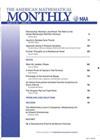Abbott Dimension, Mathematics Inspired by Flatland
IF 0.4
4区 数学
Q4 MATHEMATICS
引用次数: 0
Abstract
AbstractWhat is the “right way” to define dimension? Mathematicians working in the early and middle 20th-century formalized three intuitive definitions of dimension that all turned out to be equivalent on separable metric spaces. But were these definitions the “right” ones? What would it mean to have the “right” definition of dimension? In this paper we attempt to inspire thought about these questions by introducing Abbott dimension, a geometrically intuitive definition of dimension based on Edwin Abbott’s 1884 novella Flatland. We show that while Abbott dimension has intuitive appeal, it does not always agree with the classical definitions of dimension on separable metric spaces.MSC: 54F45 AcknowledgmentThe author would like to thank Kate Franklin for her reading of, and input on, early drafts of this paper. The author would also like to thank the referees and editors for this paper whose input greatly improved it. This work was supported by the Israel Science Foundation grant No. 2196/20Notes1 Alternative formulations of what a separator could be do exist. Indeed, in what was perhaps the first precise formulation of dimension, Brouwer in [Citation5] defined his invariant, the dimensiongrad, of a space. This invariant is identical in definition to the large inductive dimension we have defined with the difference being that instead of using separators it uses the notion of a cut. A cut in a space X between disjoint closed subsets A and B is a third closed set C⊆X that is disjoint from A and B and is such that any continuum K⊆X that intersects A and B must also intersect C. This definition of dimension agrees with the classical definitions mentioned in the introduction on the class of compact metrizable spaces (see [Citation7]).2 Interestingly, for the classical definitions of dimension the result does not hold if the space is infinite dimensional. In [Citation8] a compact metric space of infinite dimension (with respect to any of the classical definitions) is constructed such that every subspace is either also infinite dimensional, or zero dimensional.3 In 1920 Knaster and Kuratowski asked in [Citation12] if a nondegenerate homogeneous continuum in the plane must be a closed curve. The next year Mazurkiewicz asked in [Citation13] if every continuum in the plane which is homeomorphic to all of its nondegenerate subcontinua must be an arc. In [Citation11] Knaster would give an example of a hereditarily indecomposable continuum in 1923. In [Citation2] Bing would answer Knaster and Kuratowski’s question negatively with his own construction in 1948, and Moise would answer Mazurkiewicz’s question negatively in [Citation14]. Moise dubbed his example the “pseudoarc” due to its similarity to an arc. Bing would go on in [Citation3] to show that his, Knaster’s, and Moise’s examples were all homeomorphic. This history and the results surrounding the pseudoarc can be found in [Citation15].4 One may denote the set of all continua in Rn by C(Rn) and endow it with the Hausdorff metric dh. Given two continua X,Y∈C(Rn),dh(X,Y) is the infimum over all ϵ>0 such that X⊆B(Y,ϵ) and Y⊆B(X,ϵ). Here B(X,ϵ) is the open metric ball about X of radius ϵ. The result we reference says that hereditarily indecomposable continua are a dense subset of this space.Additional informationNotes on contributorsJeremy SiegertJeremy Siegert received his Ph.D. in mathematics from the University of Tennessee Knoxville. He is currently a post-doctoral fellow at the Ben Gurion University of the Negev in Beer Sheva, Israel.雅培维度,受平面启发的数学
定义维度的“正确方法”是什么?20世纪早期和中期的数学家们形式化了三种直观的维度定义,结果证明它们在可分离度量空间上是等价的。但这些定义是“正确的”吗?拥有“正确”的维度定义意味着什么?在本文中,我们试图通过引入艾伯特维度来启发人们对这些问题的思考。艾伯特维度是基于埃德温·艾伯特1884年的中篇小说《平地》而提出的一个几何上直观的维度定义。我们表明,虽然雅培维数具有直观的吸引力,但它并不总是符合可分离度量空间上维数的经典定义。作者要感谢Kate Franklin对本文早期草稿的阅读和投入。作者也要感谢审稿人和编辑,他们的投入大大改进了本文。这项工作得到了以色列科学基金会第2196/20号拨款的支持。实际上,在可能是第一个精确的维数表述中,browwer在[引文5]中定义了他的不变量,空间的维数梯度。这个不变量在定义上和我们定义的大归纳维是一样的不同之处在于它没有使用分隔符而是使用了切的概念。在不相交的闭子集A和B之间的空间X中的切是与A和B不相交的第三个闭集C和X,并且使得与A和B相交的任何连续体K和X也必须与C相交。这个维数的定义与紧度空间类的介绍中提到的经典定义一致(参见[引文7])有趣的是,对于维数的经典定义,如果空间是无限维,结果就不成立了。在[Citation8]中,构造了一个无限维的紧致度量空间(相对于任何经典定义),使得每个子空间要么也是无限维的,要么是零维的1920年,Knaster和Kuratowski在[Citation12]中提出,平面上的非退化齐次连续体是否一定是闭合曲线。第二年,Mazurkiewicz在[Citation13]中问道,平面上与所有非简并次连续体同胚的连续体是否一定是弧。在1923年,Knaster给出了一个遗传上不可分解连续体的例子。在[Citation2]中,Bing在1948年用自己的结构否定地回答了Knaster和Kuratowski的问题,而Moise在[Citation14]中否定地回答了Mazurkiewicz的问题。Moise将他的例子称为“伪弧”,因为它与弧相似。Bing在[引文3]中继续证明了他、Knaster和Moise的例子都是同胚的。这段历史和围绕伪弧的结果可以在[Citation15]中找到我们可以用C(Rn)表示Rn中所有连续体的集合,并赋予它豪斯多夫度规dh。给定两个连续体X,Y∈C(Rn),dh(X,Y)是所有≥0的最小值,使得X⊥B(Y, λ)和Y⊥B(X, λ)。这里B(X, λ)是半径为λ X的开度规球。我们引用的结果表明,遗传不可分解连续体是这个空间的密集子集。作者简介:jeremy Siegert jeremy Siegert在田纳西大学诺克斯维尔分校获得数学博士学位。他目前是以色列贝尔舍瓦内盖夫本古里安大学的博士后研究员。
本文章由计算机程序翻译,如有差异,请以英文原文为准。
求助全文
约1分钟内获得全文
求助全文
来源期刊

American Mathematical Monthly
Mathematics-General Mathematics
CiteScore
0.80
自引率
20.00%
发文量
127
审稿时长
6-12 weeks
期刊介绍:
The Monthly''s readers expect a high standard of exposition; they look for articles that inform, stimulate, challenge, enlighten, and even entertain. Monthly articles are meant to be read, enjoyed, and discussed, rather than just archived. Articles may be expositions of old or new results, historical or biographical essays, speculations or definitive treatments, broad developments, or explorations of a single application. Novelty and generality are far less important than clarity of exposition and broad appeal. Appropriate figures, diagrams, and photographs are encouraged.
Notes are short, sharply focused, and possibly informal. They are often gems that provide a new proof of an old theorem, a novel presentation of a familiar theme, or a lively discussion of a single issue.
Abstracts for articles or notes should entice the prospective reader into exploring the subject of the paper and should make it clear to the reader why this paper is interesting and important. The abstract should highlight the concepts of the paper rather than summarize the mechanics. The abstract is the first impression of the paper, not a technical summary of the paper. Excessive use of notation is discouraged as it can limit the interest of the broad readership of the MAA, and can limit search-ability of the article.
 求助内容:
求助内容: 应助结果提醒方式:
应助结果提醒方式:


